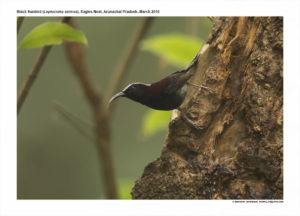Black Sunbird

Black-throated Sunbird Aethopyga saturata
Etymology:
- Aethopyga : Greek word aithos – fire, burning heat; puge– rump
- Saturate : Latin word for Richly coloured derived from satura-rich
Distribution in India: Resident of Himalayas and North East of India.
Description: Size of the male is 14–15 cm, wt. of male is 5·5–6·5g; size of female is 10 cm, wt. of female is 5·5 g. The male has elongated central tail feathers. The male of nominate race has crown and nape in metallic violet-purple, side of neck and back are crimson-brown or maroon, narrow yellow band on lower back, uppertail-coverts are metallic purple-blue; uppertail is metallic purple-blue, upperwing is blackish-brown; lores, face and throat to upper breast are blackish, broad metallic purple or blue malar stripe, lower breast is unglossed and blackish, rest of underparts are pale greyish-olive to greenish-grey; iris is brown; bill is brownish-black to black; legs are dark horn-brown to dark brown. The female is olive-green above, with grey crown, yellow band on lower back, tail is graduated and with greyish-white tips; greyish-olive below, except for whitish flanks. The juvenile is similar to female, but tail not so graduated, and white tips are not so distinct. The male later develops dark maroon on mantle, wings, tail and breast.
Habitat: It is found in primary forest, heavily disturbed forest and regenerating secondary forest, dense jungle edge, scrub, secondary growth, gardens and along shady streams. It is found at 820–2200 m, down to 305 m in winter.
Food habits: It eats nectar, pollen and arthropods. It forages singly and in pairs, from canopy down to understorey, sometimes on ground. It Nectar-robs the flowers.
Breeding habits: They breeds in in Jan–Mar in India, Feb–May and Sept in Nepal, Apr in Myanmar; Feb–Apr and Jun in Malay Peninsulaand in Apr in Thailand. The nest is built by female alone. The nest is pear-shaped, entrance hole is one-third from top and with a porch and made from felted vegetable down or dry grass, moss, lichens, rootlets, fibre from fern rhizomes, and cobwebs, decorated externally with wood chips and bamboo leaves, lined with soft seed down, attached to thin branch of bush or creepers or to tips of tree-fern fronds above ground. They lay a clutch of 1–3 eggs.